Stop E.
Stop E is located near the base of the processional way near the southern end of the hippodrome (see Figures FT-1, 2). The cinder track represents only ~15% of the total area of the hippodrome; most of the hippodrome extends north of the cinder track. A thin layer of silt and clay covers the actual surface of the hippodrome; the silt and clay represent an influx since the time of last use of the hippodrome.
To gain perspective on the nature of the lower sanctuary it is useful to walk north along the dirt road and the hippodrome proper for 025 km to
(Figure FT-14; see also Figures FT-1, 2). In doing so you will begin to appreciate the flat nature of the hippodrome space, especially in contrast to the general topography of the mountain. You will also be able to see the location of the ancient retaining wall built along the eastern margin of the hippodrome. The bath is located just beyond the north end of the hippodrome (see Figure FT-2), and the blocks used in construction of it are derived from Thick White Limestone Beds (Figure FT-15).
Figure FT14. North view from Agios Elias to lower sanctuary area.
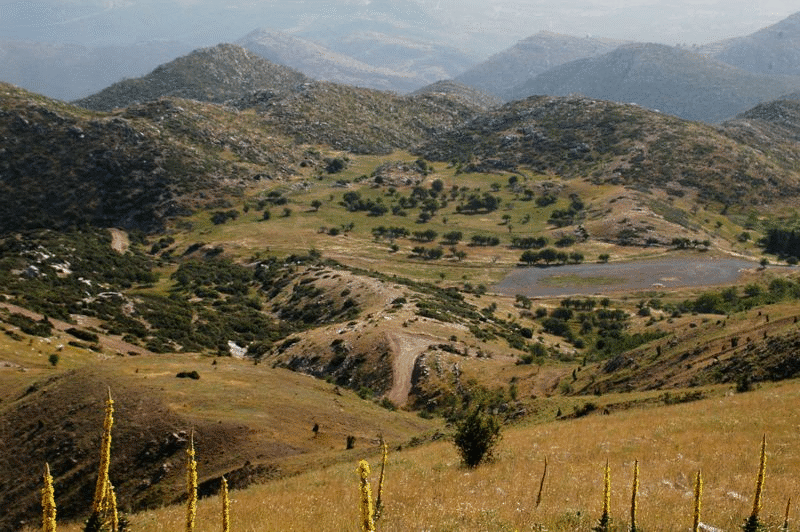
North-directed view from the flank of Agios Elios across the hippodrome to the area of the bath. In the foreground, the grass-covered hills are mainly underlain by First Flysch Beds. These occupy the Zeus thrust sheet. The segment of road in the near middle ground crosses the upper part of the Pan thrust sheet just below the Lykaion thrust fault. Bedrock exposed next to the road is Flysch Transition Beds. The ridge descending from the road to the flat expanse is the processional ridge. The middle ground and distant ground on the extreme left exposes Thick White Limestone Beds. The cinder track (dark gray) in right middle ground is the site of athletic competitions associated with the modern Lykaion games. It covers the southernmost part of the hippodrome. Most of the hippodrome lies north-northwest of the cinder track; it is a grass-covered expanse, but also contains on the order of twenty trees. Note a straight line separating dark green grass (on to the west) from lighter grass (on the east). This is the location of the retaining wall for the hippodrome. The bath is located just off the northeastern corner of the hippodrome. North of the baths is sink-hole hill.
Figure FT15. Bath near hippodrome.
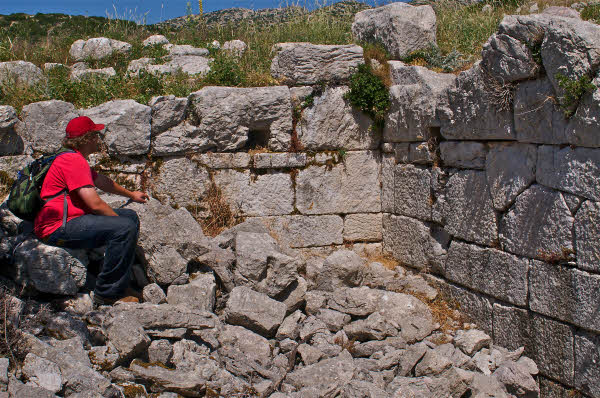
Close-up view of baths, with walls composed of blocks of Thick White Limestone Beds. Geologist is Karl Yares.
Hike northward ~0.2 km the hill to the location of Stop E2. The bedrock is Thick White Limestone Beds. If you choose to hike all the way to the top of this hill you will see that there is a find a sink hole at the crest (see Figure FT14). From anywhere on the slope where Stop E1 is designated, there are perfect south-directed views of the layout of the Sanctuary of Zeus, Mt. Lykaion, and its underlying geology (Figure FT-16). The highest point on the south horizon is the ash altar, at the very top of Agios Elias. The hippodrome and bath are in the immediate foreground. Above the level of the hippodrome near the base of Agios Elias is the trace of the Lykaion thrust fault (see Figure FT-16). This fault stands out sharply, in part because the modern road near the base of the northern slope of Agios Elias follows closely the trace of the Lykaion thrust fault. The landscape above the trace of the thrust is occupied by the Zeus thrust sheet in general, and the St. Elijah klippe in particular. Agios Elisas is smooth and rounded, locally rilled, and underlain dominantly by First Flysch Beds. Bedrock exposures are meager. In contrast, directly below the Lykaion thrust is a landscape dominated by limestone outcrops within the Pan thrust sheet (see Figure FT-16). The limestone just below the thrust belongs to the Flysch Transition Beds. Beneath the Flysch Transition Beds are Thick White Stylolite Beds. Not particularly visible from this vantage is the presence of Chert Series Beds in the immediate hanging wall of the Lykaion thrust fault.
Figure FT16. South view from Stop E2 toward lower sanctuary area.
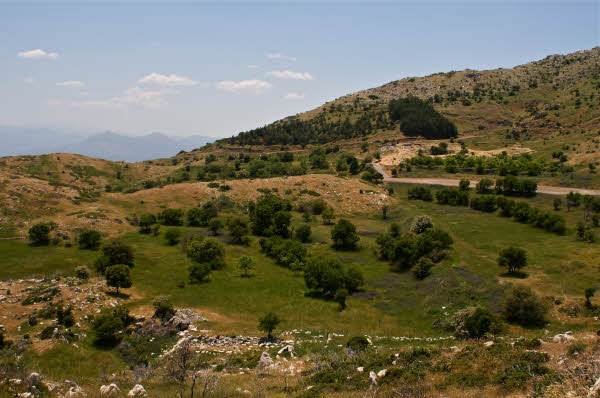
South directed view of lower sanctuary from sink-hole hill. The baths are in the immediate middle foreground. The trace of the Lykaion thrust fault essentially runs along brown-purple road in background and separates the Zeus thrust sheet (above) from the Pan thrust sheet (below). The hippodrome is in the right middle-ground. The gray, cinder part of the hippodrome is the track used for the Modern Lykaion Games. Just beyond the cinder track are the excavations of the lower sanctuary (the stoa location, marked by abundant white limestone blocks, lies just beneath the brown-purple road). Limestone outcrops on the far horizon are mainly Thick White Limestone Beds. Much of the St. Elijah klippe in this particular view is underlain by First Flysch Beds. The reddish soil/rock immediately above the road is the expression of Chert Series Beds.
From the vantage of Stop E2 it is possible to appreciate the structural geological location of the area containing the stoa, xenon, seating area, and stoa spring (Stop E3; see Figures FT-2). These built structures occupy the uppermost part of the Pan thrust sheet and are located just beneath the Lykaion thrust fault (see Figure FT-15). Furthermore, the geomorphic character of the processional way can be appreciated from Stop E2 (see Frontispiece).
Depending on time and interest, there are two routes to Stop E3. The easiest and shortest way is to head southwest to the dirt road that runs along the west side of the hippodrome. There are good bedrock exposures in the roadcuts. In walking south along this road, you will go from Thick White Limestone Beds to Flysch Transition Beds (see Figure FT-2). The longer route is to head southeast from Stop E2 and eventually climb up onto the ridge of limestone east of the hippodrome (see Figure FT-14). In so doing you will have a chance to see typical outcrop expressions of Thick White Limestone Beds, and to cross into and see the properties of Flysch Transition Beds (see also Figure FT-2). The Flysch Transition Beds formation has thinner and smoother bedding than the Thick White Limestone Beds. Furthermore, there are distinctive layers of bedded black chert in the Flysch Transition Beds (Figure FT-17). The total distance of this leg of the walk is ~0.6 km.
Figure FT17. Black chert layer within Flysch Transition Beds.
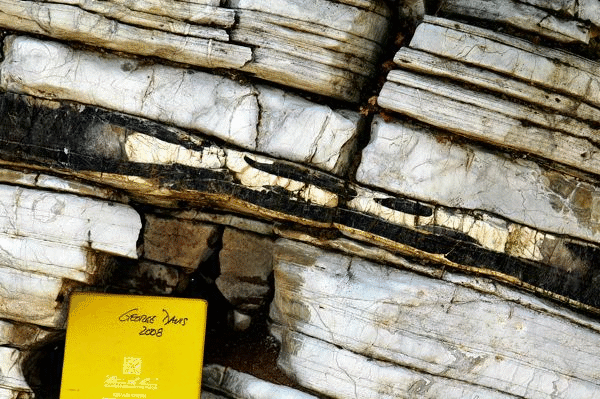
Photography of outcrop of limestone beds and black chert layers within the Flysch Transition Beds.
Stop E3.
At Stop E3 you will be able to see the stoa, seating, xenon, and a fountain house for a spring (Figure FT-18A; see also Figures FT-1, 2). Nearly all of the blocks that were worked and placed to form these built structures are derived from Thick White Limestone Beds (Figure FT-18B). It is interesting to examine the fabrics and structures that are evident in the blocks, especially the abundant stylolites, en echelon gash veins, and crystal-fiber veins.
Figure FT18. View of seatwall and stoa.
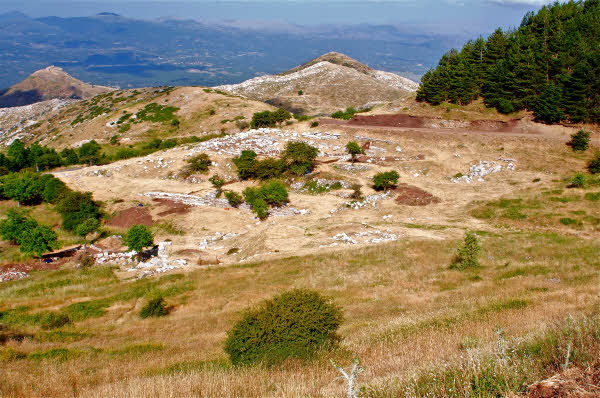
A. East-directed photograph of built structures within the lower sanctuary. The red road cut in background is a useful reference, for it is composed of sheared, weathered Chert Series Beds, which comprise the immediate hanging wall of the Lykaion thrust. The trace of the thrust itself runs along the uppermost part of the near bank of the road, just above the backwall of the stoa, whose large rectangular footprint is strewn with worked blocks of Thick White Limestone Beds. On the next terrace down is a long narrow rectangular seating area (or steps) also comprised of worked blocks of Thick White Limestone Beds. Of the two spire-like hills in the background, the one on the left is the hill on which the tiny chapel to St. George was built.
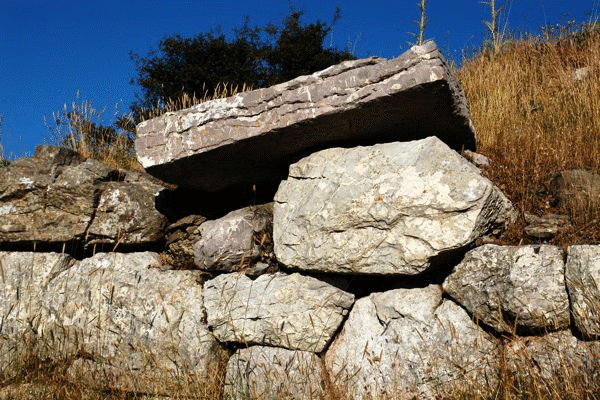
B. Photograph of a part of the backwall of the stoa. The worked limestone blocks are from Thick White Limestone Beds.
Geologically the most important part of Stop E3 is to gain a sense of the location and character of the Lykaion thrust fault. To do so, proceed east to the fork in the road, and then begin to walk up the road. As you do so you will walk along the eastern back wall of the stoa. The outcrops you see in the roadcuts display the characteristic red-purple hue of Chert Series Beds, which occupy the Zeus thrust sheet directly about the fault. In places you will see some displays of radiolarian (ribbon) cherts within the Chert Series Beds, but the outcrop quality is not nearly as good as what we will see later. Above the road, on the hill slopes, are abundant resistant outcrops and benches of brown sandstones of the First Flysch Beds (Figure FT-19). Below the road are spotty but distinctive outcrops of rocks of the lower thrust sheet, namely limestones of the Flysch Transition Beds. [Section VI-B of the companion paper gives descriptions of the “Chert Series Beds;” section VI-C gives descriptions of the “First Flysch Beds”].
Figure FT19. Seatwall in foreground, St. Elijah klippe in background.
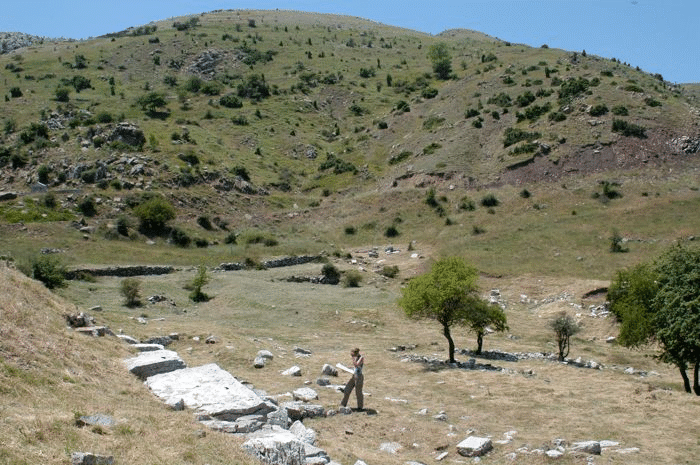
South-directed photograph toward Agios Elios, and the St. Elijah klippe. In foreground Pam Jordan draws limestone blocks comprising the seat wall in the lower part of the sanctuary. Beyond her in the middle ground are foundation walls of the xenon. The road in the background ‘travels’ right along the Lykaion thrust fault. Note reddish material on right in the roadcut. This rock belongs to the Chert Series Beds. Above the Chert Series Beds and making up much of the lower reaches of the klippe is First Flysch Beds. The brown sandstone layers within the First Flysch Beds crop out as bedrock hummocks of resistant though jointed rock.
Now return to the vehicles and begin driving to Stop F (see Figure FT-1). It is an ~1.5 km drive.
Proceeding from Stop E to Stop F.
Throughout much of this stretch of dirt road you are driving essentially along the trace of the Lykaion thrust fault (see Figures FT-2 and FT-14). This will be evident because of the striking contrast between the limestone-rich bedrock of the Flysch Transition Beds that occupies the top of the Pan thrust sheet, and the distinctive lithologies of the Chert Series Beds and First Flysch Beds that occupy the lower part of the Zeus thrust sheet. Within the Chert Series Beds the dominant lithologies are ribbon cherts and red mudstones. Within the Flysch Transition Beds the dominant lithology by far is gray limestone.
The geological properties of some of the outcrops in the roadcuts will attract your attention, especially, for example, where the Chert Series Beds are profoundly sheared and folded, and where the Flysch Transition Beds display a ‘tombstone topography’ marked by clear outcrop expression of thin beds of dipping limestone.